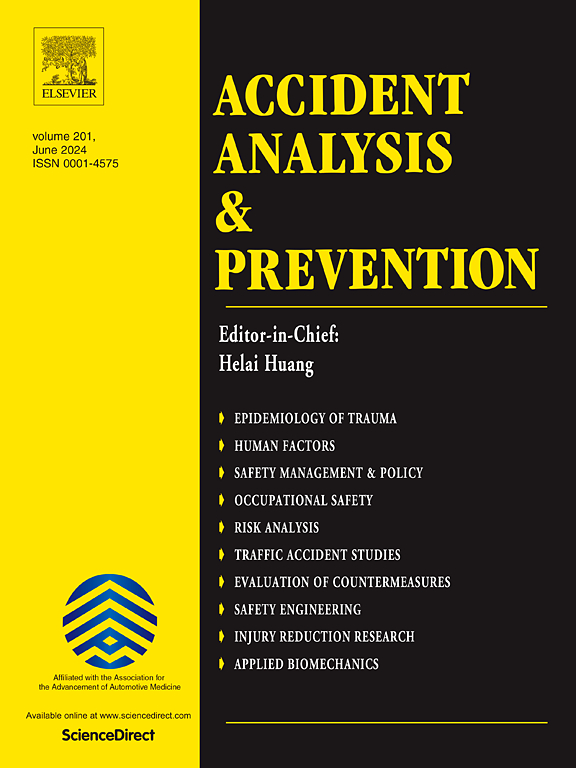A perspective from competitive-cooperative driving modes: Identification of vehicle merging behavior models and crash risk factors in merge zone
IF 6.2
1区 工程技术
Q1 ERGONOMICS
引用次数: 0
Abstract
In highway and expressway merge zones, merge behavior is the most fundamental maneuvering behavior and is a major cause of traffic conflicts and collisions. While some studies have employed vehicle trajectory data to simulate and investigate microscopic merge behavior, most have failed to consider the interaction between vehicles and have not fully investigated the factors that influence merge risk using vehicle trajectory data. This study considers the interactions between vehicles during the merging process and, based on a “competitive-cooperative” driving mode perspective, proposes a new method for classifying vehicle merging behavior modes in merging zones. It also explores the differences in risk levels and influencing factors between different merging modes. Using aerial-captured merging vehicle trajectory data, and based on previous research and actual observations, merging behaviors are classified into free, homeostatic, competitive, and cooperative modes (FM, HM, CmM, and CoM) according to the gap distance and microscopic interaction between vehicles before and after merging. The lane change risk index (LCRI) is introduced as an alternative safety measure to assess the risk of merging vehicle groups. The k-means algorithm is used to classify the LCRI, and a separate ordered logit model is constructed for each merging behavior mode. The modeling results indicate that classification modeling performs better than all data modeling, and the risk level of merging vehicle groups is closely related to the motion state of the merge vehicle, the average and standard deviation of the longitudinal speed difference between vehicles, and the gap distance between vehicles. The risk levels of the four merging modes and their influencing factors differ, with FM having the lowest risk, followed by CoM, HM having a higher risk, and CmM having the highest risk. The study results provide an in-depth analysis of merge zone risk factors, offering a theoretical basis for improving traffic safety management measures.
竞争-合作驾驶模式视角下的车辆归并行为模型及归并区碰撞危险因素识别
在高速公路和高速公路合流区,合流行为是最基本的机动行为,是造成交通冲突和碰撞的主要原因。虽然有一些研究利用车辆轨迹数据来模拟和研究微观归并行为,但大多数研究都没有考虑车辆之间的相互作用,也没有充分研究影响车辆归并风险的因素。本研究考虑了车辆在归并过程中的相互作用,基于“竞争-合作”驾驶模式的视角,提出了一种新的归并区车辆归并行为模式分类方法。探讨了不同并购模式之间风险水平的差异及影响因素。利用航拍归并车辆轨迹数据,在前人研究和实际观测的基础上,根据归并前后车辆之间的间隙距离和微观相互作用,将归并行为分为自由模式、自稳态模式、竞争模式和合作模式(FM、HM、CmM和CoM)。引入变道风险指数(LCRI)作为一种可替代的安全措施来评估车辆群合并的风险。使用k-means算法对LCRI进行分类,并为每个合并行为模式构建一个单独的有序logit模型。建模结果表明,分类建模优于所有数据建模,合并车辆组的风险等级与合并车辆的运动状态、车辆间纵向速度差的平均值和标准差以及车辆间的间隙距离密切相关。四种合并模式的风险水平及其影响因素不同,FM风险最低,CoM风险次之,HM风险较高,CmM风险最高。研究结果对合流区风险因素进行了深入分析,为完善交通安全管理措施提供了理论依据。
本文章由计算机程序翻译,如有差异,请以英文原文为准。
求助全文
约1分钟内获得全文
求助全文
来源期刊

Accident; analysis and prevention
Multiple-
CiteScore
11.90
自引率
16.90%
发文量
264
审稿时长
48 days
期刊介绍:
Accident Analysis & Prevention provides wide coverage of the general areas relating to accidental injury and damage, including the pre-injury and immediate post-injury phases. Published papers deal with medical, legal, economic, educational, behavioral, theoretical or empirical aspects of transportation accidents, as well as with accidents at other sites. Selected topics within the scope of the Journal may include: studies of human, environmental and vehicular factors influencing the occurrence, type and severity of accidents and injury; the design, implementation and evaluation of countermeasures; biomechanics of impact and human tolerance limits to injury; modelling and statistical analysis of accident data; policy, planning and decision-making in safety.
 求助内容:
求助内容: 应助结果提醒方式:
应助结果提醒方式:


